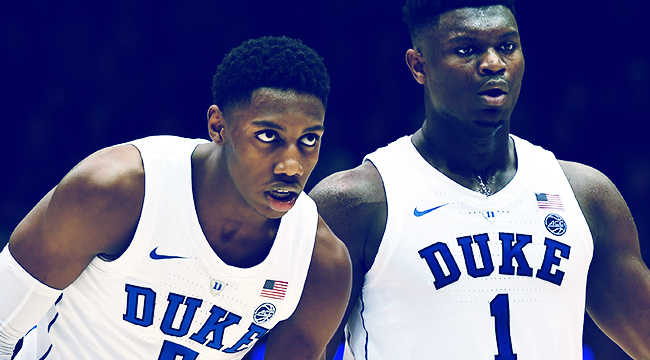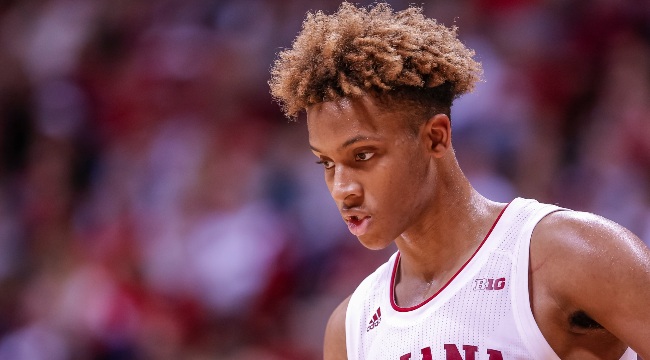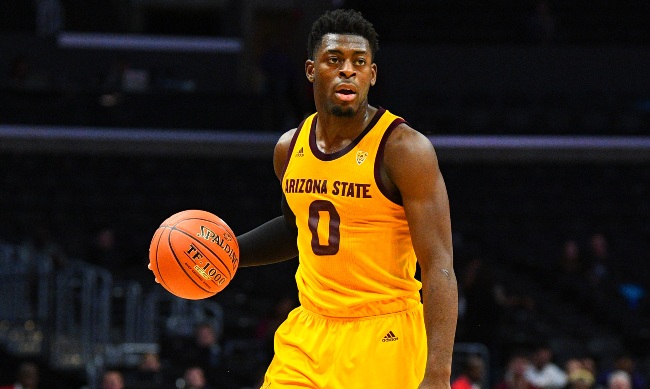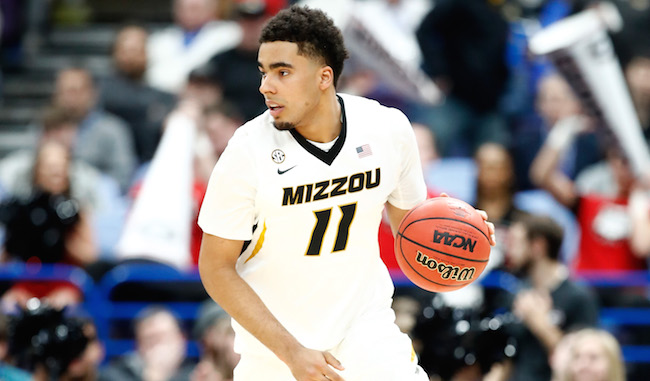
College football season, aside from the national title game between Alabama and Clemson, is essentially over. The NFL will have the headlines in the sports world for the new few weeks as the Super Bowl approaches, but football is about to give way to basketball.
The calendar flipped to 2019 and, in the NBA, there are story lines every single day that make the news cycle both difficult to follow and intriguing. At the college level, conference play is heating up and, after the dead period that is the holidays (with final exams cramping everyone’s style), marquee match-ups and prime pre-draft evaluation situations are developing.
To put it plainly, it is officially NBA Draft season. Yes, we’ve been monitoring college prospects since the ball was tipped in November and, in truth, things began well before that with camp settings and the EYBL/AAU circuit. Still, it is time to put the pedal to the metal, meaning the unveiling of another mock draft.
Our first installment scratched the surface, but with more data available, let’s roll through the 30-team first round projection as of early January.
*Note: Draft order using FiveThirtyEight projection as of Jan. 3*
1. New York Knicks – Zion Williamson (F, Duke)
It doesn’t matter which team is in the top spot. It might be fair to say that some view Williamson and Barrett as 1-A and 1-B but, simply put, it isn’t a view that I share. Williamson is the best prospect in the class and, even if there are fit issues with whichever team lands at No. 1 after the lottery, he should be the choice. In this case, that means the made-for-TV partnership between the high-flying forward and the bright lights of New York.
2. Cleveland Cavaliers – R.J. Barrett (G/F, Duke)
Some view Barrett in his own tier as the definitive No. 2 pick in this class. That might come to fruition by the time June arrives but, at the moment, he simply leads the next tier for me. Candidly, the fit between Barrett and Cavs point guard Collin Sexton wouldn’t be ideal by any means, even if Barrett’s talents could still be utilized in Cleveland. His decision-making hasn’t always been perfect in Durham, but Barrett is a tremendous talent that is worthy of an investment like this.
3. Phoenix Suns – Cam Reddish (F, Duke)
The Duke trio doesn’t have to be the top three, but it wouldn’t be a shock if they are. Reddish is a weird evaluation, in part because of the presence of Williamson and Barrett, but he’s a fantastic talent. He’s been in a pure supporting role but the talent clear and it is easy to see how he fits in the modern NBA. Phoenix wouldn’t necessarily be a perfect landing spot but, in January, we’re taking more of a big-picture approach and he’s No. 3 in my board.
4. Atlanta Hawks – Nassir Little (F, North Carolina)
I’m still buying Little. Like Reddish, he’s had a weird freshman season, part of that stems from North Carolina having two established players in the frontcourt that are taking reps away. From a college basketball perspective, that actually makes some sense, but Little isn’t being allowed to showcase his full range of talent. In the grand scheme, he’s still been pretty good (particularly on a per-possession basis) but the lack of exposure seems to be dampening his draft stock in some circles. That’s not the case for me.
5. Chicago Bulls – DeAndre Hunter (F, Virginia)
This is an extremely Bulls pick. Hunter returned for another season despite lottery upside in 2018, which appears to be the right choice at the moment. He’s a worthy high-lottery pick in this class (a group that isn’t as talented as 2018) and Hunter’s been fantastic at the college level. He probably doesn’t have star upside offensively but Hunter’s growth as a shooter and creator has been stark and, defensively, he checks every box that you would want. Admittedly, he’s the kind of player I’m prone to love, but Hunter is the real deal.

6. Orlando Magic – Ja Morant (G, Murray State)
This would have felt high for Morant a few weeks ago and it still might be. He’s been absurdly good this season, however, and it’s easy to see how this works in the NBA. Morant will need to get stronger and more consistent with his jump shot but it’s becoming difficult to ignore his pure traits and production. The Magic are in desperate need of a point guard, making this a snug fit.
7. Washington Wizards – Keldon Johnson (G/F, Kentucky)
The Wizards are in a supremely weird place and your guess is as good as mine with regard to what they do in terms of overhauling the roster. With that as the backdrop, Johnson does a lot of things well and doesn’t take anything off the table. He isn’t the sexiest lottery prospect in this class but he’d fit almost anywhere, including the nation’s capital.
8. Brooklyn Nets – Kevin Porter (G/F, USC)
Porter hasn’t appeared in a game since early December, as he is nursing a thigh injury. That, combined with USC being off-the-radar in a college basketball sense, has kept Porter’s breakout quiet, but he looks the part of a lottery pick. His upside as a scorer is significant and Porter is a big-time athlete. It will be interesting to see how he progresses when (and if) he returns at the college level.
9. Boston Celtics (via Sacramento) – Bol Bol (C, Oregon)
A foot injury will sideline Bol for the remainder of the season and add even more weirdness to this evaluation. On one hand, Bol is exceptionally intriguing with his size, offensive skill level and theoretical ability to protect the rim. On the other, he was a complete mess defensively before the injury occurred and there is a ton of risk involved in snatching a big man with foot issues with a lottery pick. Boston has multiple picks, which lessens the downside, but projecting Bol is really tough and it becomes more difficult with the lingering injury issue.
10. Atlanta Hawks (via Dallas) – Jarrett Culver (G/F, Texas Tech)
Culver is a much safer prospect than Bol. That much is certain. He’s not a ridiculous athlete but, aside from that, there aren’t many flaws with the sophomore and there are even rumblings that he is still growing physically. Even at his current size, he brings a fun combination of present-day skill and translatable upside, with Culver rising a ton since the season began.

11. Boston Celtics (via Memphis) – Romeo Langford (G/F, Indiana)
Boston’s first pick in this mock is a risky one but Langford really isn’t. Honestly, the entire evaluation comes down to whether you think Langford can shoot from the perimeter at the next level. If you buy that, No. 11 is too low. If you don’t, No. 11 might be too high. There is some safety in the way he can score from multiple levels, though, and his athletic tools should translate defensively to provide a reasonable floor.
12. Minnesota Timberwolves – KZ Okpala (F, Stanford)
Ozpala is a super fast riser in this class, to the point where this might be too high for him. There is a lot to like, though, and he is flying under the radar in the midst of a brutal Pac-12. He wasn’t very good as a freshman but, offensively, there is an intriguing package of length and a nice shooting release that will entice scouts. If he can defend in the way his tools might allow, there is a lottery pick in there.
13. San Antonio Spurs – Rui Hachimura (F, Gonzaga)
Hachimura is doing what a lot of people thought he could do in his third season at Gonzaga. He’s the most productive player on a potentially elite college basketball team and his numbers have been off-the-charts. There are lingering questions about his jumper despite clear improvement but, for me, this question is ceiling. Does he have a varied enough offensive game to really pop at the NBA level? Hachimura is going to be a pro for a long time, but upside is the question.
14. New Orleans Pelicans – Darius Garland (G, Vanderbilt)
Despite missing most of his freshman (and likely only) college season, Garland should be in the lottery mix. He was the No. 1 point guard prospect in the class coming into the year and, despite Morant’s breakout, it wouldn’t be wholly unreasonable to still have him there. Garland’s offensive polish is intriguing and, if he adds much-needed strength, he’ll be an NBA starter with room to grow beyond that. There is real appeal to that profile at the end of the lottery.
15. Charlotte Hornets – Daniel Gafford (C, Arkansas)
Gafford keeps hanging around this area and, honestly, that makes sense. He joined Hunter as potential 2018 lottery picks that returned to school but, unlike Hunter, there doesn’t seem to be much more in the way of upside to Gafford’s draft stock. There’s nothing wrong with a modern big man that can run the floor, rebound and finish at the rim, though, and the Hornets could use him.

16. Miami Heat – Luguentz Dort (G, Arizona State)
Dort kind of feels like a Miami player. His defensive potential is really impressive, as he carries a tough, physical frame that is accompanied by a 6’9 wingspan. Offensively, there isn’t anything that will blow you away but Dort has been able to score and make enough threes to positive influence his draft stock. Efficiency on that end of the floor might always be a concern but he is switchable enough on defense to set a nice baseline.
17. Detroit Pistons – Tre Jones (G, Duke)
Unlike Garland and Morant, Jones doesn’t bring a ton of offensive upside to the table. What he lacks in that category, Jones makes up for in defensive instincts and the ability to engineer an offense. For a lot of NBA teams, point guard isn’t an issue, but Detroit isn’t on that list and this pick combines need with reasonable value.
18. Boston Celtics (via LA Clippers) – Nickeil Alexander-Walker (G/F, Virginia Tech)
Alexander-Walker had some brief first-round buzz last year before it tapered away. This time around, the Virginia Tech sophomore appears to be sticking around, and with good reason. His three-point shooting has been off the charts in the early going and, even if slightly unsustainable, that is a legitimate plus. Throw in a quality defensive profile on paper and you have the recipe for a first-round pick with versatility.
19. Los Angeles Lakers – Sekou Doumbouya (F, France)
If we’re being honest, it is really hard to figure out where to slot Doumbouya right now. He isn’t playing as a result of a thumb injury and, even before that, this was a tough evaluation. He is young and talented, with great length (6’11 wingspan) and easy-to-see upside. Still, he hasn’t played against the best competition and this will be a very team-dependent pick.
20. Portland Trail Blazers – Brandon Clarke (F, Gonzaga)
Clarke is older than you would want and he isn’t a dynamic shooter by any means. Why, then, is he getting chatter as a first-round prospect? Well, Clarke is a fantastic defender and he plays hard. That can only take some players so far, but Clarke is also a big-time athlete and there is enough offensive development in his profile to set the stage for a career as a very useful role player.

21. Utah Jazz – Jontay Porter (C, Missouri)
Porter caught a brutal break when he tore his ACL after coming back to school. That will certainly ding him in some circles but, on the other end, he brings a truly fascinating offensive skill set to the table as a modern NBA big. There have always been whispers about Porter’s conditioning and NBA body from a defensive standpoint but it’s tough to pass on what he can do offensively. In Utah, he would have a chance to come along slowly but, more than anything, this is a “best prospect available” choice.
22. Houston Rockets – Coby White (G, North Carolina)
Add White to the list of players that have unquestionably helped their draft stock over the first two months of the college season. There is still at least some question as to whether White will be a one-and-done in Chapel Hill but he’s impressed with the ball in his hands and brings good size to the table if you believe he’s a point guard at the next level. He isn’t a perfect fit in Houston but the Rockets could definitely use an infusion of talent on their second unit.
23. Indiana Pacers – P.J. Washington (F, Kentucky)
If Washington becomes what he can become, every team in the NBA could use what he brings. He’s a big-time rebounder and defensive prospect, with the ability to fill in the gaps offensively as a low-usage, high-efficiency player. Make no mistake, there is very little that is “sexy” about his game, but Washington is still young and has a 7’3 wingspan to use on the defensive end.
24. Philadelphia 76ers – Admiral Schofield (G/F, Tennessee)
It is impossible not to like Schofield. He flies around on defense, is switchable in every way and is clearly an off-the-charts competitor. Throw in the fact that he can really shoot it and you have a player that would be a theoretical fit virtually anywhere in the NBA. He wasn’t “supposed” to be a first-round pick but, for a team like Philly, adding a modern role player makes a ton of sense.
25. Boston Celtics – Quentin Grimes (G, Kansas)
In about two months, Grimes went from sure-fire lottery pick to the potential of either staying in school, transferring or falling out of the first round. In fact, No. 25 is higher than most would project Grimes to go at this stage. That feels crazy based on how effective he was on the pre-college circuit and the Celtics have the ability to roll the dice given their situation. Grimes is a lottery talent and his weirdness at Kansas is something Boston can overlook.

26. Brooklyn Nets (via Denver) – Charles Matthews (G/F, Michigan)
Matthews could easily fall out of the first round and that would be justifiable. If he doesn’t develop a more reliable jumper, the Michigan wing will likely bounce around the NBA in something of a hybrid stopper role. In Brooklyn, though, he’d be landing in a quality player development environment, and Kenny Atkinson’s reputation for developing wings (particularly ones with shooting questions) makes this a perfect fit.
27. Oklahoma City Thunder – Ty Jerome (G, Virginia)
Jerome isn’t exactly a typical first-round pick in the modern era. He’ll be 22 years old in July and, despite the fact that this is only his third season at Virginia, it feels as if he’s been in college forever. Quietly, though, Jerome is rising on draft boards as a product of his balanced skill set. He projects as a potential 40 percent three-point shooter that can also play on the ball a bit and, defensively, Jerome has shown to be adequate. Is he a flashy prospect? Absolutely not, but the Thunder could use someone with his profile.
28. Milwaukee Bucks – Ignas Brazdeikis (F, Michigan)
Defensively, there are some question marks here, but they might be overblown. Brazdeikis is, at the very least, competitive on that end and he does a good job with positioning to overcome some of his weaknesses. Make no mistake, though, this is an offense-based pick and the combination of his shooting and intriguing play-making would be fun in Milwaukee.
29. Golden State Warriors – Jaxson Hayes (C/F, Texas)
Hayes wasn’t on the radar even a few weeks ago but it’s tough to ignore what he is capable of defensively. In truth, projecting him to the Warriors is more of a laugh than anything else, as Golden State has already invested too many late first-round picks in project big men. Still, Hayes has the look of a first rounder on the defensive end and, if things keep trending that way, he’ll have to consider declaring.
30. San Antonio Spurs (via Toronto) – Grant Williams (F, Tennessee)
If you ask two scouts about Williams, you’ll probably find that one of them loves him and the other does not. What isn’t in doubt is that Williams is an awfully good college player, partnering with Schofield to lead a fantastic Tennessee team. He doesn’t have a prototypical NBA game, though, and you have to rely on his do-it-all nature and some level of projection in his jumper. He might fit better as a second-round pick in some ways but the Spurs feel like a team that could see the big-picture and grab a role player on a cost-controlled deal.






